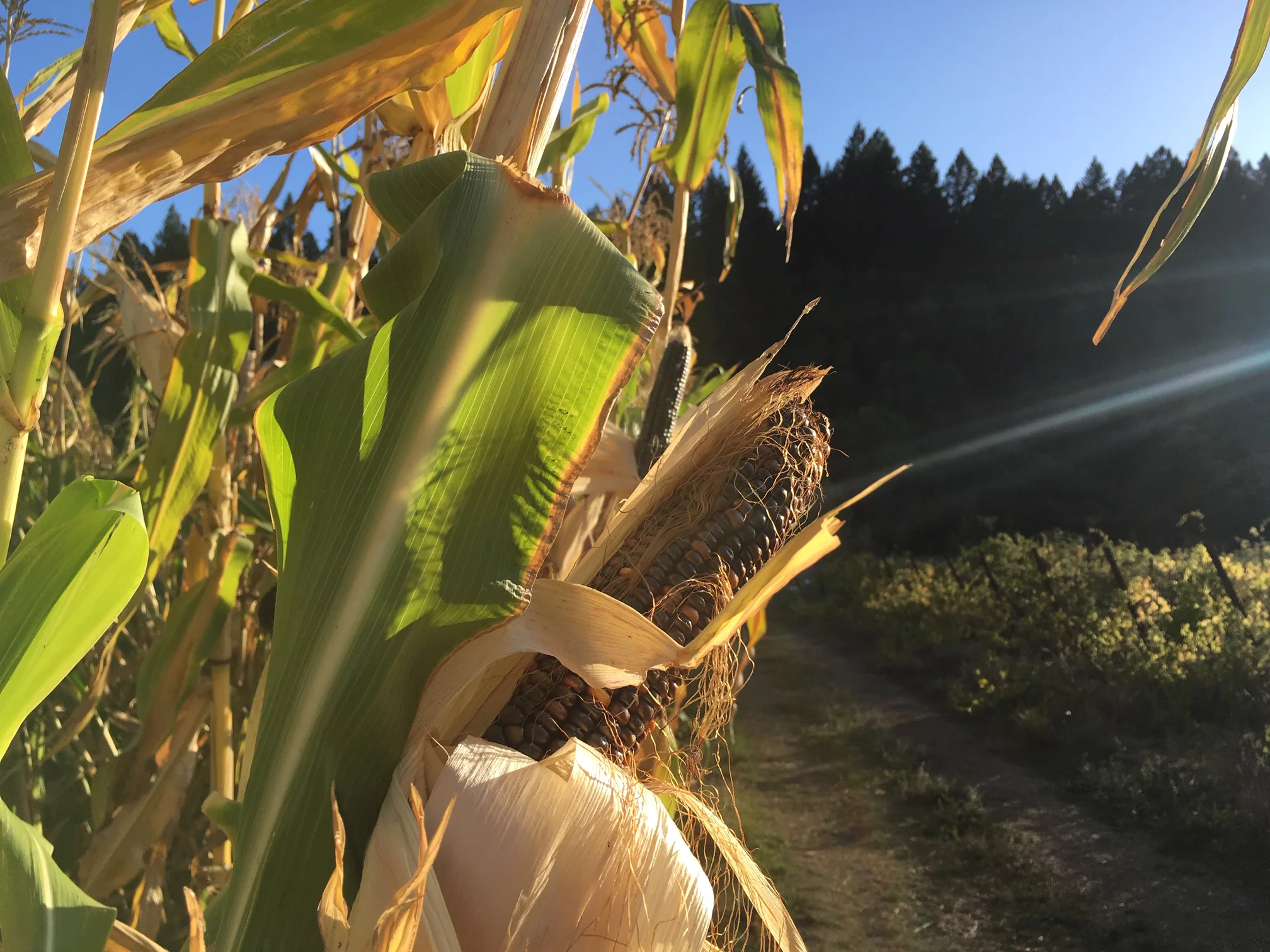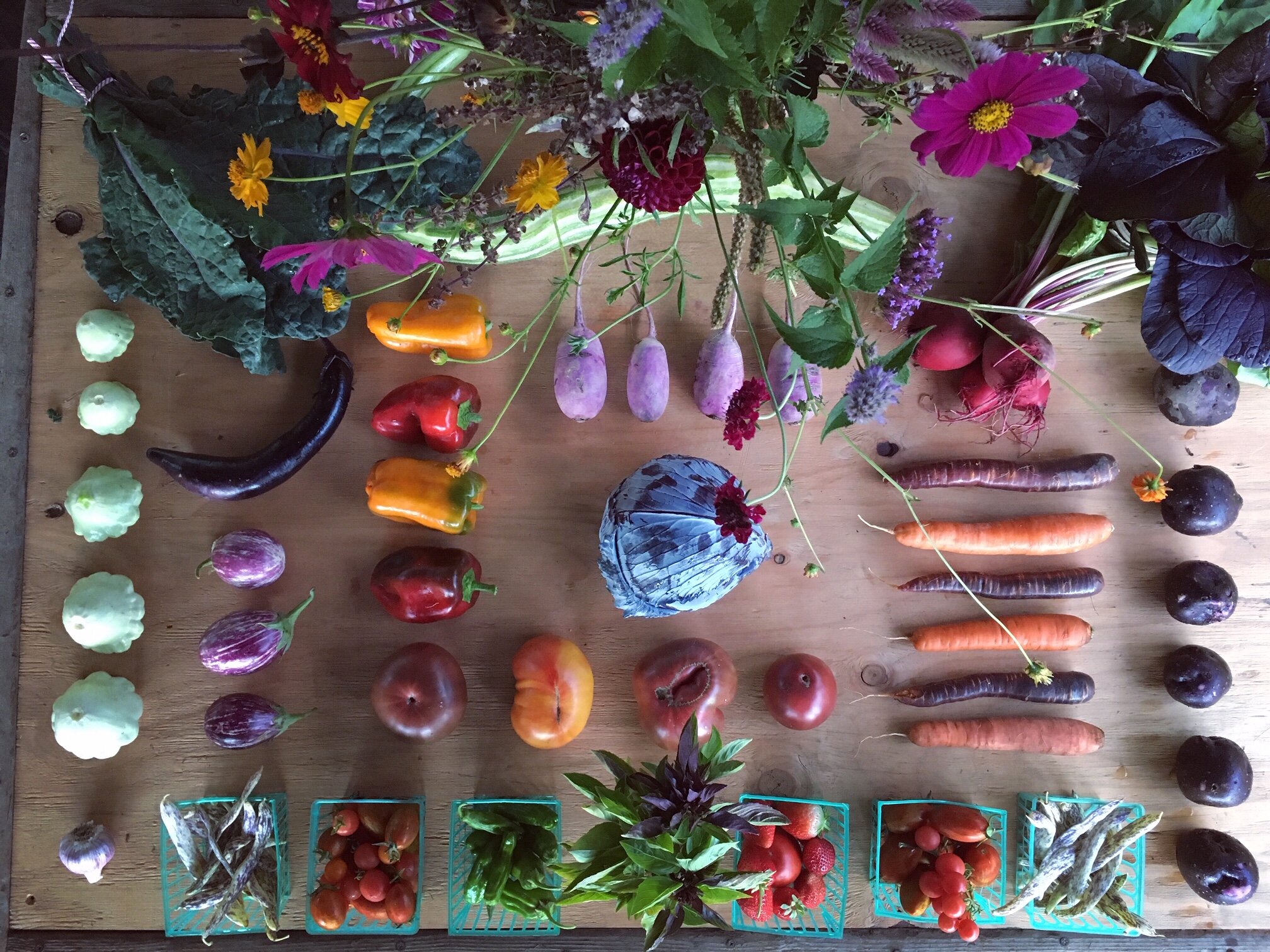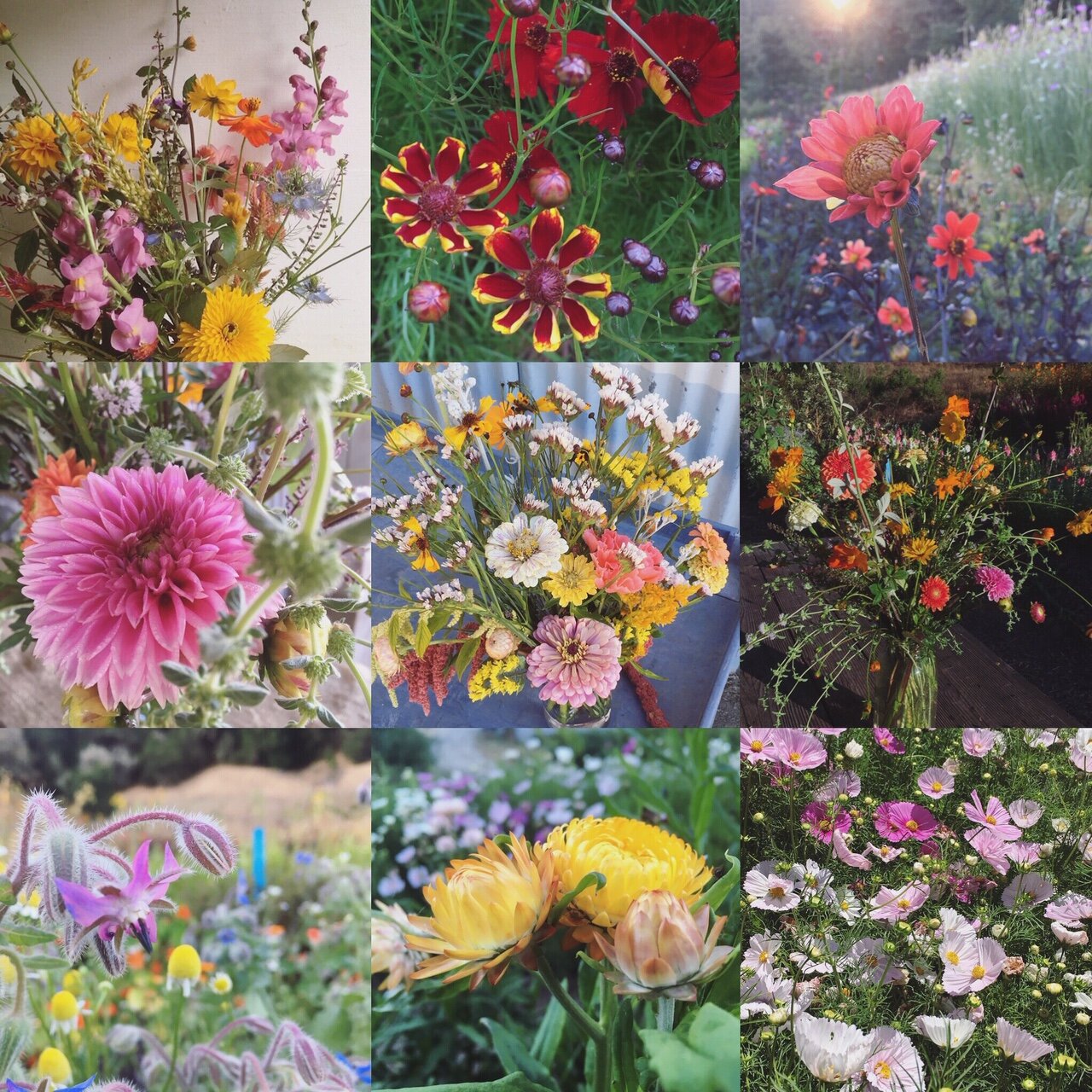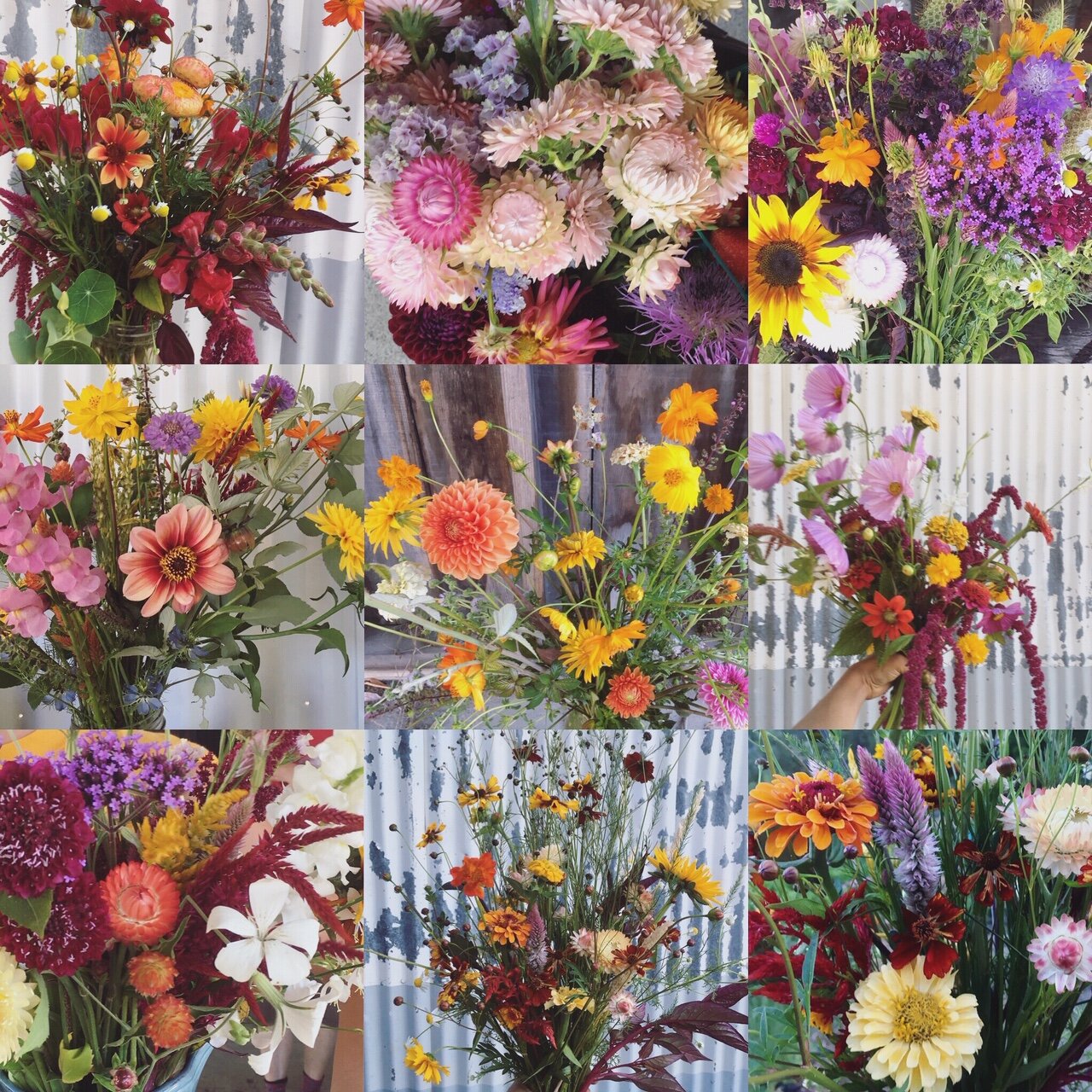CORN HARVESTS THIS WEEK!
Come one come all! It’s harvest time! We had a nice conversation with the corn (and potatoes) this morning and scheduled three major harvests in the coming weeks. We hope you can make it to one or all of these harvests to lend a hand or just take in the scene. They can be so fun and it’s an unforgettable experience bringing in a big harvest as a community. All abilities and interest levels welcome.
Hopi Blue Corn Harvest
THIS Tuesday, October 1st: 4:30pm - 6:30pm
Floriani RED FLINT Corn Harvest
THIS Wednesday, October 2nd: 10:00am - 12:00pm
Storage Potato Harvest
Saturday, October 12th: 9:30am - 12:00pm
THIS WEEK'S HARVEST
Freshly Dug La Reine Fingerling Potatoes, Green Tomatoes, Cauliflower, Green Magic Broccoli, Sweet Peppers, Mixed Loose Beets, King Richard Leeks, Rainbow Chard, Dazzling Blue Dino Kale, Olympian Cucumbers, Summer Squash and Zucchini, Rainbow Carrots, Four Families Salad Mix (with Frisee, Arugula, Nasturtium & Shungiku), Cegolaine Little Gem Lettuce, Italian Softneck Garlic
U-PICK
Classic Green Beans: NO LIMIT
Cherry Tomatoes: NO LIMIT
Frying Peppers: Winding down. Still a good number of shishitos.
Jalapeños: Just gleanings. Winding down. Located below the frying peppers
Strawberries
Herbs: Italian Basil, Tulsi Basil, Thai Basil, Purple Basil, Italian Parsley, Rosemary, Lemon balm, Lemon Verbena, Vietnamese Coriander, Annual Cilantro, French Sorrel, Onion Chives, Garlic Chives, Tarragon, Oregano, Thyme, Chamomile, Mints, Anise Hyssop, Culinary Lavender, Lemongrass
Flowers! There some really nice new Zinnia and Cosmo beds to the left of the cherry tomatoes
HARVEST NOTES
Four Families Salad Mix: This week’s salad mix is a mixture of 4 different plant families! It is a flavor packed combo of arugula (brassica), frisee (chicory), nasturtium (tropaeolaceae) and shungiku (chrysanthemum). Try it straight, or cut it with your little gem lettuces to soften its mildly spicy flavor. Shungiku is a chrysanthemum cultivated in East Asia for its leaves and flowers, which have a mild, herbal taste.
Freshly Dug La Reine Fingerling Potatoes: The final of the four potato varieties we’ve been debuting this month: La Reine, is French heirloom fingerling is prized by chefs for its buttery, waxy texture and hazelnutty flavor. It holds shape well when cooked which makes it a perfect salad potato variety. The texture when pureed makes an exceptional base for rich soups and sauces. Or, just treat them like you would any other potato! Bon appetite!
Green Tomatoes: As our summer tomato season comes to a close we’re bringing you a different form of this cherished food. In addition to the classic — fried green tomatoes — you can also use these gems in soups, stews and pots of beans as a subtly tart thickener. Check out this Green Tomato Pork Stew recipe for inspiration.
PRESERVING THE HARVEST
Bulk Pink Lady Slipper Radishes: We’ll have loads of these perfect beauties on the back table for all your pickling dreams. Their radiant pink color will make a gorgeous pickle to enjoy throughout the year. Try this elegant pickling recipe from Bon Appetite. It’s particularly good at showcasing the variety of vibrant colors coming out of the farm right now (think a rainbow of beets, carrots, turnips and radishes).
Bulk White Satin Carrots: Don’t underestimate the White Satin Carrot. We feel it is consistently our best tasting, sweetest carrot. It also happens to be extraordinarily vigorous. We’ll be putting out bulk White Satins on the back table for pickling, juicing, etc. Out of bag. Don’t be shy, take 10 pounds! Check out this wonderful recipe for pickling carrots… or any vegetable!
FALL HARVEST WORKSHOPS
We’re super excited to be hosting two Fall workshops put on by our neighbor, CSA member, and ecological educator, Lindsay Dailey. The first, tomorrow morning, is on making dye from farm flowers and the other is on corn. Both workshops are will be in our pick-up barn and are free to CSA members. Thank you, Lindsay!!
Colors of the Land
Tomorrow! Saturday, September 28th: 9am - 11am
In addition to providing beauty, pollen, nectar (and joy!), the flowers at GVCF are full of wearable color. Join us to learn the process of natural dyeing, utilizing plants to saturate fibers with various hues from nature. We’ll take a walk through the garden, look at some wild and cultivated dye plants that are abundant on the farm, and then harvest a few batches of plant material to cook up some color! We’ll discuss the process of natural dyeing, while the pots simmer, and you’ll have a colorful scarf or hankie to take home at the end of pickup. Silk bandanas and scarves (pre-mordanted) will be available to dye during the class and take home for a suggested donation of $5 - $10.
The Magic of Corn in the Kitchen and Garden
Saturday, November 2nd: 10am - 12pm
Want to make tortillas and tamales from Green Valley corn? Learn to work with the magic of corn. Lindsay — a deep student of corn — will demonstrate how to grind corn for flour, discuss recipes, and explore the alchemy of nixtamalization which makes corn sticky in order to make masa for tortillas and tamales. While we work, Lindsay and the farmers will talk about the natural history and mythology of corn and discuss planting, growing, and saving seed from this amazing plant in the home garden! And then we'll eat some fresh made tortillas! Yum!
VOLUNTEER WEDNESDAYS, 8:00-10:00 AM
Interested in some farm therapy? Come out on Wednesday mornings to help us tend the garden and farm together. Come find us in the garden or out in the main fields on Wednesdays from 8:00am 'til 10:00 am. All abilities welcome, we’ll find something comfortable for you to do!
FARMER’S LOG
pestS ON THE FARM
Fortunately, the fields and garden we tend here are home to many many friends. Unfortunately, some of them fancy the human food we grow as much as we do — but neglect to sign up for the CSA! Fortunately, due to the wildness of this place, these “pests” are kept relatively in check by myriad lifeforms that fancy to eat them. Unfortunately, the pests still cause semi-severe losses and your farmers must muster a resistance.
A CSA member requested a newsletter entry about pests and their management on the farm. For organization’s sake, we thought we’d start with the biggest honkers and go down to the smallest fries.
* * * * *
Turkeys: The chunkiest pests at Green Valley Community Farm are our dear wild turkeys. Turkeys are a non-native that seem to be gaining a strong foothold in Sonoma County. They are beautiful, intelligent creatures with intricate social relationships and can fly over a deer fence easily. They are omnivores, and cruise the landscape morning and late-afternoon and evening, browsing for seeds, insects, the occasional frog or two, and juicy leaves and forbs. Most of the year we live in happy co-habitation with our fine feathered friends. We do the dishes and mow the lawn, they eat weed seeds, cucumber beetles and pill bugs. Thanks, Turkeys! However, every few months they discover a farm food that they love more than anything and go on a binge. We usually look the other way and don’t mind the lost lettuce or two or ten. But sometimes, especially during this driest part of the year, it becomes a problem. Most of the white fabric coverings you see on crops right now are there to deter the turkeys. As for keeping the turkeys in check, we have help from Coyote (who killed one on the farm near the back fence a couple weeks ago) Bobcat, and Golden Eagle.
Gophers: The next (dimensionally) largest pesty friend on the farm is the mighty gopher. There is an old NorCal adage that gophers are what chased the Russians away from Fort Ross. Lucky for us, Green Valley Community Farm lies mostly in a wet valley that sees long periods of standing water in the winter. Gophers, therefore, cannot make year-round runs in our main fields. They do tunnel there in the dry months and cause a fair bit of damage, but winter rains flood whatever inroads they make so they live in higher concentrations up in the hills. Also lucky for us, Green Valley Community Farm is a wild place and we have tons of gopher predators: Coyotes digging for them at night and bobcats pouncing; hawks, kestrels, and owls swopping from above; gopher snakes spelunking their burrows. Last summer a Great White Egret named Ingrid took up residence on the farm from August through December and ate two or three gophers a day. We believe Ingrid’s presence last year, and that very wet winter we had, temporarily reduced their population and has made 2019 our least Gophery year thus far.
We miss you, Ingrid!
Rats and Mice in the Greenhouse: We flew under the radar our first two years here, but we’ve been found out. This year, rats and mice eating seeds and seedlings from our greenhouse trays was a huge headache. We’re nervous about curing our corn and Winter Squash in the greenhouses and are contemplating adopting a feral feline friend as a greenhouse cat.
Slugs: On which day of creation were slugs created? Monday morning!? Just kidding, slugs are beautiful in their own special way (to other slugs). Slugs get crazy for us in the Spring and late Fall, which is when their population surges due to moisture. In the Spring we must put down “Sluggo”, an organic iron phosphate pellet in order to germinate carrots, otherwise they would all get gobbled up. Other than that, it’s live and let live with the pretty little slugs and the ugly little holes they make on the bottom of our lettuce. Big props to all the frogs in the field enjoying slug escargot.
Insects: Our insect pests offer a textbook example of the natural ecology of food sources at work. Our first year we had very few classic garden insect pests. The farm had been fallow for a couple years and their populations were scant. As soon as we started planting they started eating and breeding and now we have flea beetles and cucumber beetles in good supply — but less, I think, than other farms because of our wild locale. Flea beetles, for example, who feed on brassicas and make the little pin holes on the arugula and mustard greens, are relatively chill here. This may be because we aren’t close to a large vineyard. A lot of local vineyards plant mustard as a cover crop in the winter for its anti-fungal properties. Large flea beetle populations over-winter on this cover crop. Come Spring, the vineyards mow the mustard, and the flea beetles jump on the nearest kale, broccoli, or cabbage they can find! Singing Frogs farm, next to a large Dutton vineyard, has a famously epic Spring flea beetle attack when Dutton mows. We’re lucky to have just a normal attack. As for the cucumber beetles (who look like green ladybugs), they would do a lot of damage were it not for the organic Kaolin clay (that white stuff) we spray on all our new cucurbit plantings until the plants grow strong enough to repel them on there own. And, again, the myriad birds, frogs, lizards, turkeys, and predatory insects who feed on the pest insects help us so much. One of the most beautiful things to watch on the farm is the swarms of swallows and dragonflies swooping over the fields and feeding on insects in the evenings.
Note chew marks bottom center
Garden Symphylans: They who shall not be named. Of all the antagonists written about above, none are smaller and none are scarier than the garden symphylan. Garden symphylans are quarter-inch long, blind, super fast crawling, soil dwelling arthropods that look like little white centipedes. They thrive in soils with high organic matter, good soil structure, and earth worms for they cannot dig themselves and rely on the tunnels of others to move about. They feed on decaying organic matter and, tragically, the fine white root hairs of growing plants. In high enough concentrations they annihilate everything growing in their biosphere, even weeds. We have garden symphylans in high concentrations in small patches and are still determining exactly where they are. (A strip of high-ground in field 1, a diffuse swath of the middle of field 3...) Like a photo-negative, they are where the crops are not. In a 200 foot bed of arugula 170 feet will be growing happily, with a 30 foot patch of bare ground. Garden symphylans cause more crop loss, affect the harvest share, and determine the placement of our plantings more than any other creature on the farm. They are partially responsible for why we aren’t having another 2 more weeks of melons. Unfortunately, there are no known biological, organic, or even inorganic controls for garden symphylans. We are in decent company, both Santa Rosa Junior College’s Shone Farm and UCSC’s Farm have them. One known plant deterrent is potatoes (they do not eat potato roots). That is why we planted potatoes where we did this year — in an area hard hit by them last year. And so, we will continue to experiment with plant allies as deterrents in our dance with the little white ghosts of Green Valley Community Farm.
* * * * *
Hopefully wild pigs don’t cross the Russian River because that’s all folks — A pretty short list of creatures that we must vie with for Green Valley Community Farm fare!
In the end, we are eternally grateful for them. They keep us in check. They humble us and remind us of our place in the grand scheme of things: Not above anyone, not below, but woven firmly within of the web of interrelation and inter-dependence that sustains us all.
See you in the fields,
David and Kayta

















